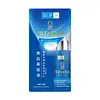What's inside
What's inside
 Key Ingredients
Key Ingredients

 Benefits
Benefits

 Concerns
Concerns

 Ingredients Side-by-side
Ingredients Side-by-side

Water
Skin ConditioningDipropylene Glycol
HumectantGlycerin
HumectantArbutin
AntioxidantTriethylhexanoin
MaskingIsopropyl Myristate
EmollientPEG-20 Sorbitan Isostearate
EmulsifyingCetyl Alcohol
EmollientCarbomer
Emulsion StabilisingTriethanolamine
BufferingGlyceryl Stearate
EmollientHydroxyethylcellulose
Emulsion StabilisingMethylparaben
PreservativeDisodium EDTA
Magnesium Ascorbyl Phosphate
AntioxidantWater
Skin ConditioningGlycerin
Humectant1,2-Hexanediol
Skin ConditioningMethylpropanediol
SolventHouttuynia Cordata Extract
Skin ConditioningCentella Asiatica Leaf Water
Skin ConditioningArtemisia Princeps Leaf Water
MaskingDipropylene Glycol
HumectantGlycereth-26
HumectantSodium Hyaluronate
HumectantPolyglyceryl-10 Laurate
Skin ConditioningPolyglyceryl-4 Laurate
EmulsifyingCaprylyl/Capryl Glucoside
CleansingCarbomer
Emulsion StabilisingArginine
MaskingBetaine
HumectantHydroxyethylcellulose
Emulsion StabilisingMelaleuca Alternifolia Leaf Oil
AntioxidantMalt Extract
Skin ProtectingEthylhexylglycerin
Skin ConditioningWater, Glycerin, 1,2-Hexanediol, Methylpropanediol, Houttuynia Cordata Extract, Centella Asiatica Leaf Water, Artemisia Princeps Leaf Water, Dipropylene Glycol, Glycereth-26, Sodium Hyaluronate, Polyglyceryl-10 Laurate, Polyglyceryl-4 Laurate, Caprylyl/Capryl Glucoside, Carbomer, Arginine, Betaine, Hydroxyethylcellulose, Melaleuca Alternifolia Leaf Oil, Malt Extract, Ethylhexylglycerin
Ingredients Explained
These ingredients are found in both products.
Ingredients higher up in an ingredient list are typically present in a larger amount.
Carbomer is a polymer of acrylic acid. Its main role is to create a gel consistency.
A high amount of carbomer can cause pilling or balling up of products. Don't worry, most products contain 1% or less of carbomer.
Dipropylene Glycol is a synthetically created humectant, stabilizer, and solvent.
This ingredient helps:
Dipropylene glycol is technically an alcohol, but it belongs to the glycol family (often considered part of the ‘good’ alcohols). This means it is hydrating and gentle on skin unlike drying solvent alcohols like denatured alcohol.
As a masking agent, Dipropylene Glycol can be used to cover the smell of other ingredients. However, it does not have a scent.
Studies show Dipropylene Glycol is considered safe to use in skincare.
Learn more about Dipropylene GlycolGlycerin is already naturally found in your skin. It helps moisturize and protect your skin.
A study from 2016 found glycerin to be more effective as a humectant than AHAs and hyaluronic acid.
As a humectant, it helps the skin stay hydrated by pulling moisture to your skin. The low molecular weight of glycerin allows it to pull moisture into the deeper layers of your skin.
Hydrated skin improves your skin barrier; Your skin barrier helps protect against irritants and bacteria.
Glycerin has also been found to have antimicrobial and antiviral properties. Due to these properties, glycerin is often used in wound and burn treatments.
In cosmetics, glycerin is usually derived from plants such as soybean or palm. However, it can also be sourced from animals, such as tallow or animal fat.
This ingredient is organic, colorless, odorless, and non-toxic.
Glycerin is the name for this ingredient in American English. British English uses Glycerol/Glycerine.
Learn more about GlycerinHydroxyethylcellulose is used to improve the texture of products. It is created from a chemical reaction involving ethylene oxide and alkali-cellulose. Cellulose is a sugar found in plant cell walls and help give plants structure.
This ingredient helps stabilize products by preventing ingredients from separating. It can also help thicken the texture of a product.
This ingredient can also be found in pill medicines to help our bodies digest other ingredients.
Learn more about HydroxyethylcelluloseWater. It's the most common cosmetic ingredient of all. You'll usually see it at the top of ingredient lists, meaning that it makes up the largest part of the product.
So why is it so popular? Water most often acts as a solvent - this means that it helps dissolve other ingredients into the formulation.
You'll also recognize water as that liquid we all need to stay alive. If you see this, drink a glass of water. Stay hydrated!
Learn more about Water